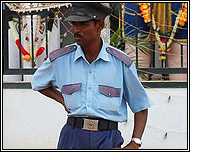A handicapped security guard and the promise of his talented daughter
December 31, 20112 mins
 [Editor’s Note: Apologies for the 9 days of hiatus in blogging. It was my first vacation since I started writing this blog. To pile on the excuses, it was my first vacation where my wife was working – so there! Wishing you all a Happy New Year and pledging that I’ll continue to strive to be a better and more prolific blogger.]
[Editor’s Note: Apologies for the 9 days of hiatus in blogging. It was my first vacation since I started writing this blog. To pile on the excuses, it was my first vacation where my wife was working – so there! Wishing you all a Happy New Year and pledging that I’ll continue to strive to be a better and more prolific blogger.]
For bloggers writing about anti-poverty and social impact initiatives, there’s a clear danger of becoming an ‘armchair intellectual’. While there’s no near-term danger of my becoming an intellectual (at least in ‘my’ eyes), there’s no such thing as too many “field trips.” Field trips to observe/interview the rural poor require some planning. Urban poor, on the other hand, are a lot more accessible. There are ample opportunities – whether it’s the security guard in one’s apartment building, the parking attendant outside Koshy’s, the beggar on a street corner, or the waiter in a restaurant – all you need is a few minutes and a patient ear.
This post marks the beginning of the Field Reports category and is based upon a series of conversations (in Telugu) with Bala Raju. Raju is a 55-year old (estimated age) security guard in Koramangala 1st block with a daughter and son. Raju walks with a strong limp – a daily reminder of a debilitating paralysis that afflicted half his body years ago. As it often happens with the poor, recovering from the paralysis severely affected the family financially. His current job as a security guard (for one of the businesses) only pays him Rs. 3,500 a month. (Security guard salaries have a wide band apparently – some pay as high as Rs. 7,000 depending on the company & the responsibilities.)
Raju’s wife is also handicapped and doesn’t work. His son dropped out of school before high school and works as an assistant in a pharmacy shop, earning Rs. 6,500 a month. It turns out that Raju’s daughter is the family genius. She finished her Pre-University Course (aka 12th grade) from SJB College with an overall 95%! By any yardstick, that’s brilliant. She now attends engineering college (majoring in Electrical & Electronics) in the Jainagar neighbourhood of Bangalore. That’s not all this kid does – she attends college in the evening and works during the day!
I asked Raju how he managed to pay his daughter’s tuition. He replied, “With the bidda (child) showing such academic promise, how could we NOT support her? We manage to raise the amount somehow.”
I had two immediate thoughts after listening to Raju’s story.
- Raju’s daughter and, by corollary, his family would greatly benefit from a Help-A-Child scholarship (or something similar)
- Surely Raju’s son could complete a vocational training course from Bangalore-based Unnati that would lead to a higher-paying job?
I shared my thoughts with Raju and he nodded his head politely but in a manner that suggested “Yeah. Talk is good but what can you REALLY do for me?” I tried to get more details about his children (college name, location, age, etc.) and repeated that I would make inquiries on the scholarship and vocational training fronts.
As I turned to walk towards my car, Raju sheepishly grinned and asked if I could spare him some lunch money. Without any demur, I gave him twenty Rupees. Can’t really blame Raju for asking. After all, talk is cheap. These vague notions of scholarships and vocational training were concepts in a nebulous future that may or most likely not happen. However, what’s tangible and undeniable is that if I did give him money, he would definitely have a superior (than usual) lunch. On a related closing note, for the poor what could possibly be more important than food?